Creating stunning living room cove lighting begins with understanding the fundamentals of indirect illumination. Thoughtful room layout maximizes light distribution, while selecting the right source ensures functionality and ambiance. Utilizing color and intensity creates desired effects, enhancing the overall aesthetic. Multi-layered lighting adds depth, avoiding common pitfalls such as harsh glare. Finally, strategically highlighting architectural features captivates attention. With these tips, one can transform their space into a welcoming environment, revealing more opportunities to elevate design.
Key Takeaways
- Choose warm LED colors (2700K-3000K) for a cozy atmosphere, ideal for living room relaxation and social gatherings.
- Conceal fixtures from sightlines to maintain aesthetic appeal and ensure a clean, elegant design.
- Utilize multi-layered lighting by combining cove with ambient, task, and accent lights for enhanced functionality and visual interest.
- Position fixtures near textured surfaces to enhance patterns and create captivating shadows that define intricate details.
- Incorporate dimmers for customizable brightness levels, allowing adaptable moods throughout the day and during gatherings.
Understand the Fundamentals of Cove Lighting
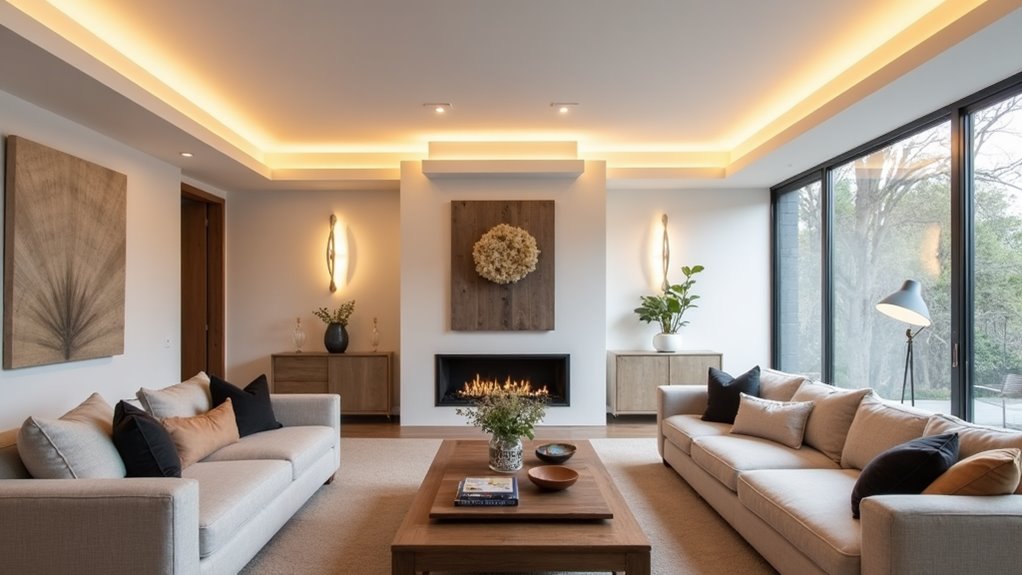
Although cove lighting is often overlooked in favor of more conventional illumination methods, it stands out as an elegant solution for enhancing the ambiance of a living room.
Understanding cove lighting basics reveals it as an indirect illumination technique where light fixtures, typically LED strips or rope lights, are concealed in architectural features such as ledges or valances. This design directs light upward towards ceilings or along walls, creating a soft, diffused glow that minimizes glare. Energy efficiency, in particular, makes LED options especially attractive for both long-term costs and environmental impact. Moreover, utilizing various lighting types in cove designs enhances flexibility and allows customization to fit diverse living room aesthetics.
Reflective surfaces, particularly lighter tones, help disperse light, enhancing spaciousness while accentuating architectural details. By skillfully integrating these elements, cove lighting develops a warm, inviting atmosphere, proving to be both functional and aesthetically pleasing in modern interior design.
Plan Your Room Layout for Optimal Placement
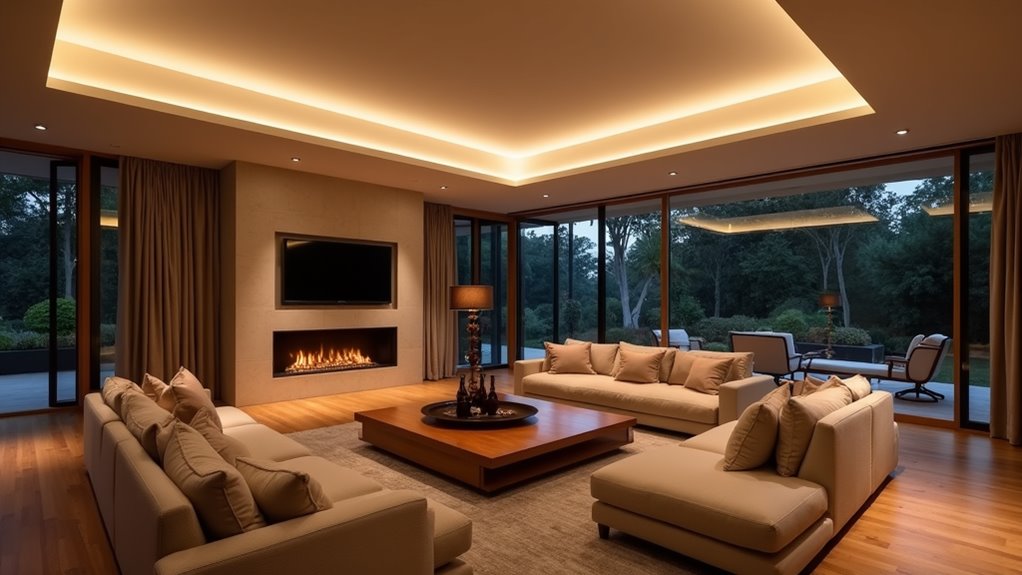
With a firm grasp of the fundamentals of cove lighting, attention turns to the strategic planning of room layout to maximize its effectiveness. The placement of lighting fixtures should consider room dimensions and architectural features while avoiding glare on reflective surfaces. Higher ceilings can enhance dramatic effects, requiring fixtures positioned at optimal angles. Additionally, they must be mindful of existing openings to ensure seamless integration with natural light.
| Feature | Consideration | Impact |
|---|---|---|
| Ceiling Height | Higher ceilings accommodate dramatic effects | Requires higher lumens |
| Room Size | Larger rooms need extended light | Improves overall brightness |
| Wall Texture & Color | Light colors enhance reflectivity | Allows for lower lumens |
| Visibility of Fixtures | Conceal fixtures from sight lines | Maintains aesthetic appeal |
| Traffic Patterns | Avoid glare risks in high-traffic areas | Enhances safety and comfort |
Choose the Right Light Source for Your Needs

Choosing the right light source for cove lighting can significantly enhance the aesthetic and functionality of a living room.
LED versatility stands out as an optimal choice, offering long-lasting solutions with customizable color temperatures and dimmable capabilities to curate desired atmospheres.
For those seeking bright, consistent illumination in larger spaces, fluorescent brightness proves valuable; however, the design flexibility can be limited.
Conversely, rope lighting serves as a charming option for creating soft, ambient options around curves and irregular areas, enriching the overall warmth of the space.
Each light source presents unique benefits, making it essential to evaluate the specific needs of the living room to achieve the perfect balance between functionality and style.
Create Desired Effects With Color and Intensity
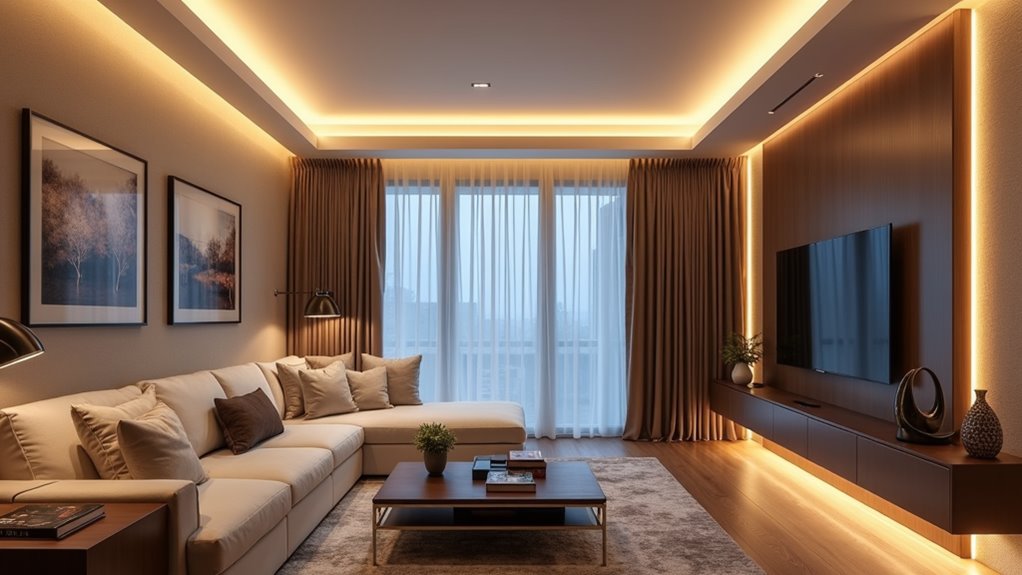
The interplay of color and intensity in cove lighting creates an impactful atmosphere within a living room, significantly shaping its mood and functionality. Color psychology plays a vital role, as different color temperatures—ranging from warm to cool—evoke distinct emotional responses. Warm whites foster coziness, while cooler hues enhance alertness. Additionally, varying light intensity further refines the lighting ambiance, with dimmable options allowing for adaptable settings as activities change throughout the day.
| Color Temperature | Effect |
|---|---|
| 2700K-3000K | Cozy, inviting |
| 4000K-5000K | Energetic, focused |
| 4500K-6500K | Crisp, mimics sunlight |
| 200-500 Lumens | Mood lighting |
| 400-1000 Lumens | Primary light source |
Strategic application produces a transformative environment, enhancing both aesthetics and usability.
Enhance Design With Multi-Layered Lighting
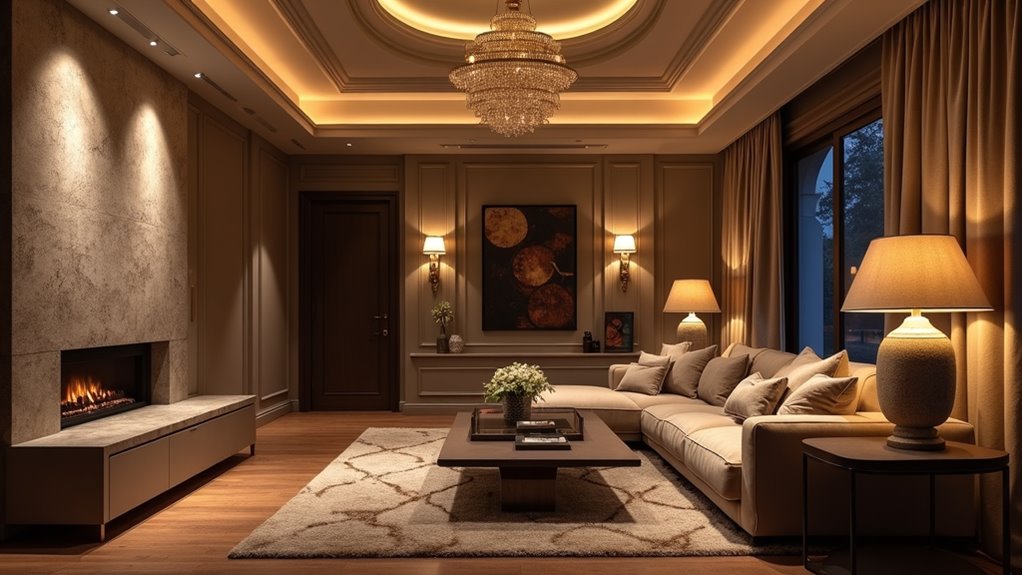
While many homeowners seek to create an inviting atmosphere, few recognize the transformative power of multi-layered lighting in achieving this goal.
By skillfully incorporating natural elements like cove lighting, spaces become more functional and visually appealing. Ambient lighting provides a soft glow, while task lights focus on specific activities, and accent lights highlight architectural features.
This balance enhances mood lighting, allowing flexibility throughout different times of the day. Integrating cove lighting with other fixtures, such as wall sconces or recessed lights, can create depth and dimension, enriching the room’s character.
Layered lighting solutions not only prevent a flat appearance but also invite warmth and sophistication, ensuring that each corner of the room delights the eye.
Avoid Common Pitfalls in Cove Lighting Design
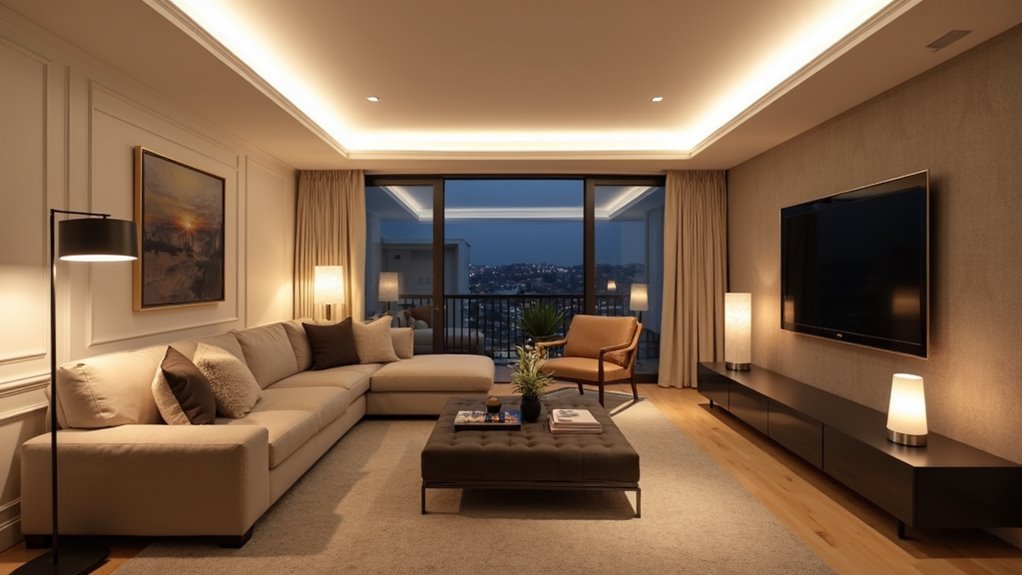
When embarking on cove lighting design, it is crucial to navigate several common pitfalls that can undermine the desired aesthetic and functionality.
Proper lighting fixture selection is essential; choosing inappropriate brightness levels or mismatched color temperatures can lead to harsh glare and disjointed visuals.
Furthermore, paying attention to placement and spacing is vital for effective shadow management; poorly positioned fixtures may create dark spots and uneven lighting.
The dimensions and construction of the cove also matter, as shallow or improperly angled designs can expose fixtures or trap light, reducing effectiveness.
Lastly, integrating dimmers and ensuring accessibility for maintenance fosters an adaptable and harmonious lighting scheme that complements the overall ambiance.
Avoiding these issues enhances the cove lighting experience.
Utilize Cove Lighting to Highlight Architectural Features
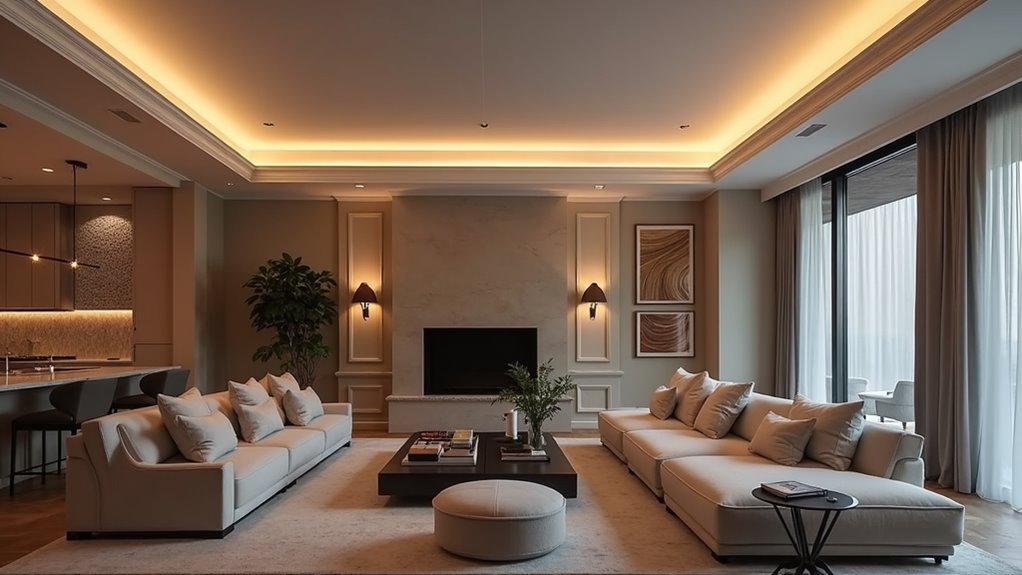
Cove lighting serves as a powerful tool in accentuating the intricate beauty of architectural features within a living room. By illuminating crown moldings and textured walls, it not only enhances their visual appeal but also creates dynamic interplay between light and shadow, adding depth to the space.
Furthermore, strategically placed cove lights can draw attention to architectural niches, transforming them into elegant focal points that enrich the overall design.
Emphasize Crown Moldings
As crown moldings gracefully adorn the edges of a room, utilizing cove lighting to illuminate these architectural features transforms them into standout elements of design.
The uplighting method, where light is directed upwards, enhances the profile of various crown molding styles, creating a soft and inviting ambiance. By concealing lighting materials, such as LED strip lights, behind the moldings, the light source becomes invisible, allowing for a seamless, elegant look.
A grazing effect can accentuate intricate details, while perimeter highlighting emphasizes the room’s dimensions. This interplay of light and shadow not only showcases the craftsmanship of the moldings but also adds a sophisticated depth, making the crown molding a prominent feature that elevates the overall design aesthetic.
Showcase Wall Textures
The interplay of light and texture can transform a living room into a captivating visual experience, where architectural features are accentuated in remarkable ways.
Utilizing cove lighting, various texture materials—such as stone, brick, and wood—can be illuminated to reveal their intricate details. By employing the wall grazing technique, fixtures positioned close to textured surfaces create pronounced shadow effects, enhancing the patterns and contours of these materials.
Moreover, varying light angles and temperatures can magnify the richness of colors in stone and wood panels alike, while uniformly washing textured plaster walls adds depth and intrigue.
The careful placement of LED strips amplifies these effects, inviting a dynamic ambiance that captivates and engages.
Accent Architectural Niches
Architectural niches can serve as stunning focal points within a living room, and utilizing cove lighting to accentuate these features elevates both their aesthetic appeal and functional presence.
By strategically installing cove lighting, the depth and dimension of niche shelving are enhanced, creating captivating visual interest. The soft, diffused glow directs light upwards, erasing harsh shadows and fostering a warm ambiance ideal for relaxation. Unique displays can be highlighted without spotlighting, while fixtures remain concealed, maintaining the elegance of the design.
This approach harmonizes with various architectural styles, ensuring niches blend seamlessly or stand out as desired. Ultimately, clever integration of cove lighting transforms these niches into alluring, inviting features that enrich the overall living environment.


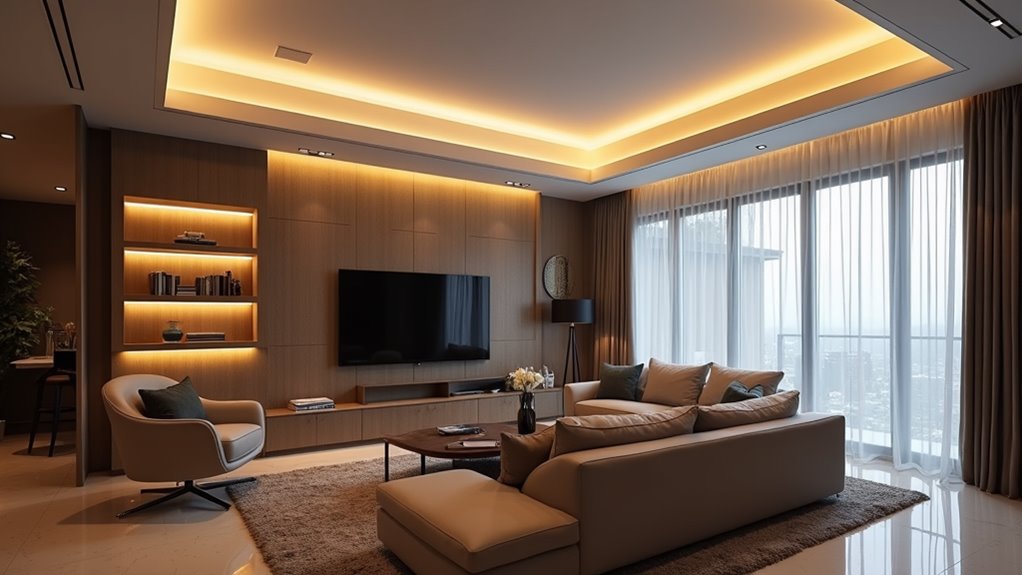
Bài viết cùng chủ đề:
10 Essential Living Room Lighting Trends for 2025
Top 5 Living Room Track Lighting Fixtures for Modern Homes
3 Brilliant Ideas for Living Room Floor Lighting
7 Tips for Perfect Living Room Ceiling Recessed Lighting
10 Brilliant Living Room Overhead Lighting Ideas
Top 5 Semi-Flush Living Room Lighting Fixtures for 2025